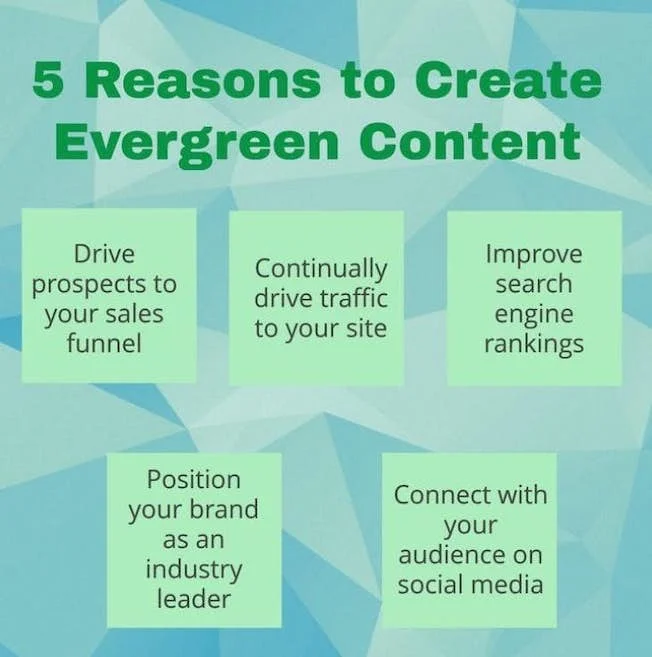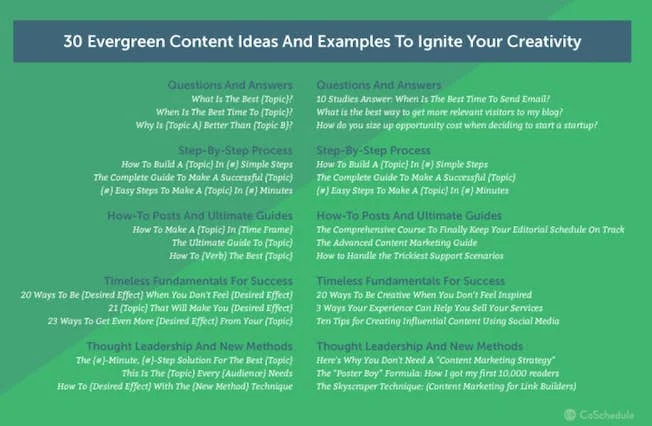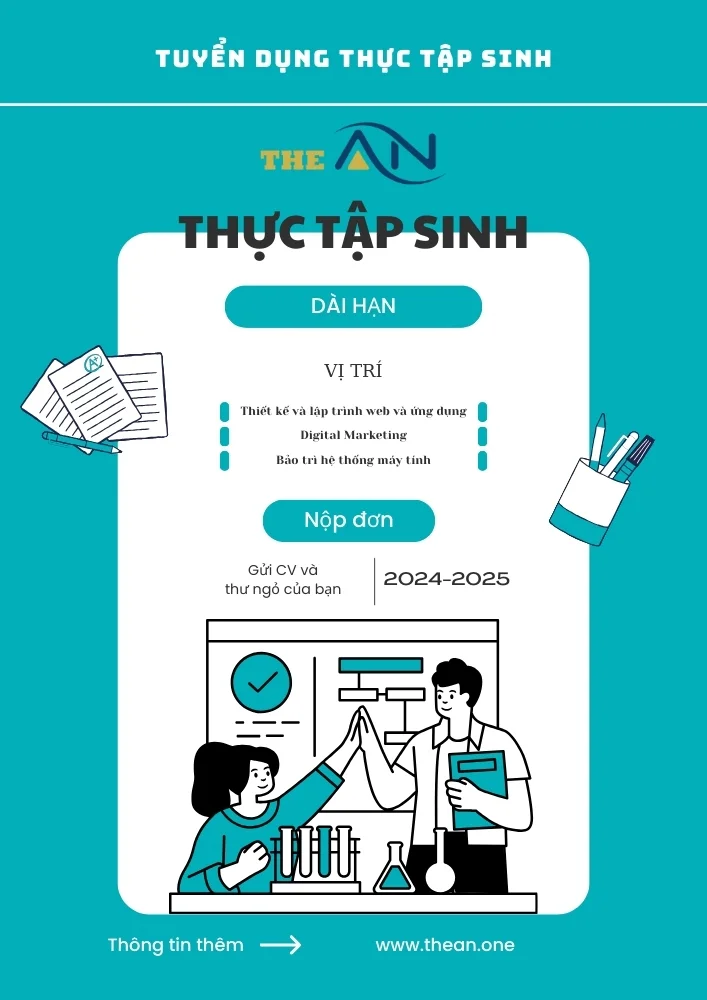The Beginner’s Guide to Evergreen Content

What is evergreen content and how can you leverage it for your content marketing strategy? Put simply, it's content that retains relevance, it's not time sensitive and continues to drive traffic long after it is first published. Below, we've listed the formats that best complement this approach to content generation and how you can make it work for your business.
What is Evergreen Content?
Evergreen content is search-optimized content that is continually relevant and stays “fresh” for readers over a long period of time - as the name implies. You may think that all online content is sustainable; after all, a blog post doesn’t just disappear after you publish it. But evergreen content is different. It continues to be relevant long past its publication date, with search traffic growing over time.
Common Evergreen Formats
Below are some common evergreen formats you may consider creating:
- Listicles
- Tips
- How-to content
- Product Reviews
- (Some) videos
Producing in these formats does not automatically make your piece evergreen, but these types of content do tend to lend themselves to evergreen writing more than other formats. Instructional videos providing useful information, like how to change a tire, have more longevity than a less practical video.
Now that you understand some of the key formats for creating evergreen content, here’s how you put them into practice.
Ways to Make an Article or Blog Evergreen
- Answer frequently asked questions from your users/personas, something leveraged by Lemonade Insurance,
- Provide industry tips, "how to" explanations or advice.
- Explain common industry concepts that may be confusing for readers.

Examples of Evergreen Content
Here are some specific examples of what would be considered evergreen articles for a variety of industries:
- The Essential Guide to Social Media Marketing - this can be narrow in scope and extremely valuable for someone who is new to developing and implementing campaigns on social media.
- How to Care for a New Puppy – Animals and the internet are a pretty strong combination but pieces like this are fun and instructional for new pet owners.
- 10 Ways to Enjoy Hot Chocolate – Coming into the colder months, a blog like this can provide a lift in traffic. Twists on old classics can be a great starting point for an evergreen article.
Of course, some or all of these topics won’t be relevant to your business. You must create content that provides value to your particular audience. The difficult part of evergreen content is that often the most popular industry topics have already been covered, maybe even hundreds of times. In this case, you should add your own unique spin on the topic or search for long-tail keywords that have a decent amount of traffic but not as much competition. This will make your content more valuable and more likely to move up in the search engine results.

What Isn’t Evergreen Content
To further explain what evergreen content is, let’s look at what it is not.
To better clarify what kind of writing is considered “evergreen,” we can examine what types of pieces are specifically not evergreen.
- News articles
- Statistics or reports that will quickly go out of date
- Articles focused on pop culture or a current trend
- Current clothing and fashion trends
Remember, evergreen content has no real expiration date and retains its value long-term, so an article about a presidential election or this year’s marketing trends may be popular content for now but it won't make the cut as evergreen content.
Tips for Writing Evergreen Content
Now that you know what evergreen content definitely is and is not, along with the types of formats that work best, here are some specific tips for writing evergreen content:
- Choose the right keywords. We briefly mentioned already that longtail keywords may be best. Even the most lasting evergreen piece isn’t worth much if people aren’t searching for that topic, so do your keyword research.
- Optimize for SEO. Once you have your keywords (one per piece), don’t forget to use SEO best practices for on-page optimization. Add alt text to images, and put the keyword in the title, URL and throughout the body copy - but don’t stuff your keywords! You should also hyperlink related evergreen articles together to improve SEO rankings.
- Write for Beginners: You may feel the need to share your expertise, but do so in a way that caters to beginners. Experts aren’t likely to be searching on broad topics, and you want to generate evergreen content for a large and recurring audience.
- Avoid Overly Technical Language: Along the same vein as the previous note, beginners often don’t understand overly-technical language, so try to avoid using it whenever possible.
- Repurpose Your Content: When you create a great piece of content, there are many ways you can spin it and re-use your great ideas in various formats. Here are some great ideas for busy content editors.
Evergreen Content Isn’t the Only Way to Success
Evergreen content is great, but don’t think that everything you create needs to be (or should be) evergreen. Timely and topical pieces are also important. These pieces are perfect for short-term marketing campaigns when you want to drive a lot of traffic and leads in a small amount of time. The best content marketing strategy includes a mix of long-lasting evergreen posts and more topical articles.
Don’t Bury Evergreen Content on Your Blog
Once you’ve created your evergreen content, don’t simply bury it on your blog. If you publish your content and “set it and forget it,” you won’t get the results you’re hoping for. Instead, you need to make an effort to highlight your valuable evergreen content so that it’s immediately seen and accessible by site visitors. There are a few ways you can do this:
- Build training guide pages on your website that are targeted to beginners in the industry and help your audience quickly and easily point to your how-to and terminology content.
- Highlight your evergreen blog posts in the sidebar of your blog or in a banner on your homepage.
- Re-run top evergreen posts on your blog periodically (with updates, as applicable) to showcase your work to the largest audience.
- Create a “start here” page on your website that helps people with the basics and features tutorial content.
- Build a social media campaign around your content, across all of your networks.
The call-out method(s) you choose doesn’t matter as much as the fact that you do highlight the content and give it the best chance to succeed.
Update Evergreen Content Regularly
In addition to highlighting your content, you must also ensure that it stays up-to-date. While there shouldn’t be much you have to do to update evergreen content, there will be new findings, new articles to which you can hyperlink and other new developments. In addition, updating content and its published date can help with SEO rankings. It's an established standard that how updating evergreen content can hugely benefit SEO rankings, as reported by Neil Patel, among others. Once you’ve updated your content, promote it as if it’s a new piece.

To see if your content has dropped in the search rankings over time and should definitely be updated, use the Ahrefs positions tracker. Using this tool, you can check your weekly digest email to see which of your pages need more effort if you want your pieces to be found. Remember, there’s new content being created all the time, and some of it is going to be competing for the same keywords you’re targeting. You need to keep your content fresh and comprehensive to stay on top.
When you’re updating content, keep the following elements in mind:
- Usefulness (Can users take action immediately?)
- Clarity (Is there any confusing terminology? Does the piece flow logically?)
- Tone (Is your writing friendly, approachable, and full of expert advice?)
- Shareability (Can readers easily share the content on social media via sharing apps or otherwise?)
More Evergreen Content Ideas
Still racking your brain for some evergreen formats that will work for your business? Here’s a comprehensive list that may help. Refer back to this list when you get stuck. Creating evergreen content should be an ongoing goal for your business, so it’s likely you’ll use most of the formats at some time.
- Original Research
- Successful Case Studies
- “What Went Wrong” Case Studies
- How-to for Beginners
- How-to for Advanced Users
- How-to Checklist
- How to Choose the Best Product
- How to Do Something Over Time
- Resources List
- Best Free and Paid Tools List
- Best Books for a Specific Goal
- Common Mistakes in a Specific Niche/ Industry
- History of a Topic or Product
- “Greatest of” Round-up
- Best or Worst Practice to Meet a Specific Goal
- Complete Glossary of a Topic or Specific Niche
- Everything You Need to Know About ____.
Source: DMI
Looking for a custom web design? Then Contact the website designers at The ÂN in Vietnam via (+84).326.418.478 (phone, zalo, viber) or schedule a consultation.
Other useful information:









